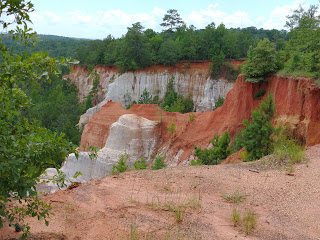Cheaha State Park is the oldest state park in Alabama, and site of the highest point in the state. It is located in east central Alabama, due east of Birmingham. This was our next stop. We took mostly
 |
| Kudzu covers everything |
secondary and tertiary roads to get there, so the ride was interesting and scenic. Kudzu was everywhere, and roadside ditches were, in many place, strewn with trash. The closer we got to Cheaha, the more the roads ran up, down, and around hills. We missed the miniscule and fading sign that directed us to the turn off for the park, and on a narrow, 2 lane road, had to drive miles down the road to a place where we could U turn without dropping our wheels into a ditch.
When we arrived at the campground to check in, we were given a map of the campground itself. If we wanted a trail map for the park, we'd have to pay $2 for it. The "trail map" that we paid for wasn't helpful at all, as it showed some of the main trails, but not all. There were no descriptions of the trails with information like length, difficulty, or elevation gain. This was to be a sign of things to come.
For dinner that evening, I set up the instant pot outside and connected it to another outlet on our power post. So we had instant pot ribs for dinner! Very cool.
The next morning, after rain overnight, we slathered ourselves with bug repellent, and took a trail to a viewpoint that overlooked the lovely Talladega Forest. When we arrived at the viewpoint, fog shrouded the view. Within minutes, though, the fog lifted and revealed an expansive view of forest, lakes and hills.
We then headed down to Cheaha Lake to have lunch. Next up, we decided to take a hike to Cheaha Falls. But nowhere on the map we were given did it locate the trail, and there is no internet or cell service in lower elevations of the campground or park. At higher elevations, it was possible to get a shaky connection. From that connection, we finally got an online trail map, and directions to the trailhead. Once there, we set off, and after about 1/4 mile, came to a fork in the trail with no signage or indication of which way to head. Naturally, we took the wrong fork, a fact that we realized a bit later. We the retraced our steps to the correct path where there were no signs, trail blazes or cairns to mark the way.
Fortunately, we made it to the falls, a lovely rocky area tucked away in the woods. Along the way, I
noted oak leaf hydrangea and many other wildflowers.
On returning from this hike, we stopped in at a Native American museum at the park. It exhibited a large arrowhead and artifact collection of a local man. This man hunted for and collected a few thousand arrowheads in northeastern Alabama. The collection was given life by the ranger who staffed the museum, someone who obviously had a passion for Native American history and life. He explained to us how the different types were made, and why some were rare and important. This was an interesting stop.
Our last visit of the day was to the highest point in Alabama, the site of a fire tower built by the CCC in the 1930s. We climbed the tower to get 360 degree views.
More photos are here: https://photos.app.goo.gl/NeCkhcFQfsGcyecQ9














